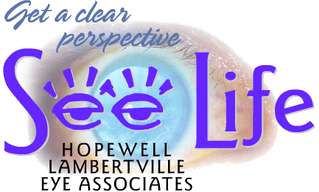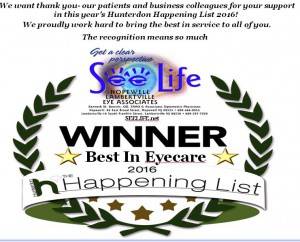Diet and Nutrition
- prepared by Hopewell Lambertville Eye

- Nutrition: Critical In Preventing Eye Disease and Maintaining Eye and Whole Body Health
- Diet and Nutrition
No, you’re not getting any younger. But eating the right foods can protect your vision and keep you healthy. Research says that foods rich in vitamins C and E, zinc, lutein, zeaxanthin, and omega-3 fatty acids are linked to lower risk for age-related macular degeneration (AMD), cataract , diabetic retinopathy and even dry eye.But what does this nutrient-rich diet look like? Let’s break it down:- Vitamin C. Foods with lots vitamin c are oranges, grapefruit, kiwifruit, strawberries, tomatoes, red and green peppers, and broccoli.
- Vitamin E. Healthy sources of vitamin E include almonds, sunflower seeds, olive oil, and avocadoes.
- Zinc. Legumes (beans and lentils), seeds, meat/seafood, dairy, and eggs are all good sources of zinc.
- Lutein and zeaxanthin. Both of these nutrients are found naturally in the retina—the light sensitive tissue lining the back of the eye. This is why boosting your diet with lutein and zexanthin is a win for your eye health. Lutein and zexanthin—often found together in many foods—are part of the “carotenoid” family of plant pigments. Carotenoids give color to many vegetables and fruits. You can find lutein and zexanthin in leafy green vegetables like kale, spinach, and swiss chard. Broccoli, asparagus, and colorful fruits like raspberries, papaya, peaches, and mangoes are also chock-full of eye-healthy carotenoids.
Cataract prevention in the produce aisle
Did you know that regularly enjoying a piece of fruit and a side of vegetables can help prevent vision loss from cataracts? Studies show that a diet rich in foods with antioxidants may reduce your risk of developing cataracts.
But what are antioxidants?
Put simply, antioxidants are foods that keep us healthy by delaying or slowing down oxidation, which causes aging or cell death. Oxidation can lead to cataracts by causing changes to fats and proteins in the eye’s lens, making the lens cloudy.

-
Research has shown that the damage caused by free radicals can lead to increased risk of cancer, heart disease and eye disease. What foods are antioxidants?
Foods rich in vitamins A, C and E, carotenoids, lutein and zexanthin, and selenium (pasta, bread and grains) all help protect our cells from damage.
While you can get supplements in pill form at the drug store, antioxidants are most beneficial when consumed organically from fruits and vegetables and other whole foods. Studies show that antioxidant supplements do not help prevent cataracts. Supplements may even be harmful. For example, high-dose beta-carotene supplements have been shown to increase risk of lung cancer in smokers and former smokers. High-dose vitamin E supplements increase risk of hemorrhagic stroke (stroke caused by bleeding in the brain) and prostate cancer. So load up on fresh veggies and delicious fruits—not on high-dose supplements—knowing you are doing your eyes and your health a favor.
The Mediterranean diet
- The Mediterranean diet (MD) is a healthy diet pattern that can prevent chronic age-related diseases, especially age-related eye diseases (AREDs) including cataract, glaucoma, age-related macular degeneration (AMD), diabetic retinopathy (DR) and dry eye syndrome (DES).
-
The Mediterranean diet is named after the eating habits of those living near the Mediterranean Sea. Studies show the plant- and seafood-based diet may reduce your risk of heart disease and age-related macular degeneration (AMD).
The Mediterranean diet includes:
- green leafy vegetables and colorful fruits
- tree nuts like almonds, cashews and walnuts
- seafood as your primary meat source
- healthy fats. Choose olive oil over butter
- whole grain bread, cereal, and pasta
- lots of herbs and spices added to your food to lower your salt intake
- moderate amount of dairy (yogurt and cheese) and eggs
Those from the region also enjoy a glass of red wine with dinner, which has its own health benefits (in moderation). So there is some truth to a toast of Salute (to your health)!
Low-glycemic index diet
People who have or at risk for diabetes or age-related macular degeneration (AMD) can benefit by following a low-glycemic index (low-GI) diet.
With diabetes, blood sugar levels can get too high, which causes serious health problems and can lead to vision loss. Some foods cause rapid spikes in blood sugar (high-GI) and others raise blood sugar more moderately (low-GI). You can avoid quick blood sugar spikes with low-GI food swaps:
- Oatmeal or muesli over sweetened breakfast cereal
- Brown rice over white rice
- Whole-grain bread over white bread
- Durum wheat pasta or sweet potato over a baked potato
- Nuts over potato chips
Healthy fats for dry eye
Dry eye is when the eyes do not produce enough tears to keep them lubricated and comfortable. Artificial tears and medication are very helpful, but adding omega-3 and omega-6 fatty acids to your diet may also provide relief.
Omega-3 fatty acids are found in oily fish (like salmon, trout and sardines). Nuts and oils like walnuts and sunflower oil are great natural sources of omega-6 fatty acids. Both are available as oral supplements (pills or tablets). Ask your doctor if omega-3 and omega-6 supplements are right for you.
Fish can lower AMD-risk
Studies found that women who ate fish high in omega-3 fatty acids at least twice a week were less likely to get age-related macular degeneration (AMD).
Fish is also good for your heart. The American Heart Association recommends that healthy adults eat fish at least twice a week. Some fish contain high mercury levels and should be eaten sparingly or avoided completely during pregnancy. Talk to your doctor about what fish and how much is healthy to eat if you are pregnant or become pregnant.
Calcium and AMD
Earlier studies suggested that calcium lowered the risk of developing AMD but newer research is uncertain. Emily Chew, MD, a researcher at the National Eye Institute, explains why and clarifies the role of calcium in your eye and overall health.
-
AREDS2 formula for AMD
People with certain forms of AMD may be able to slow the progression of the disease to advanced form by taking the AREDS2 supplements. This formula—developed from the Age-Related Eye Diseases Study (AREDS)—includes:
- Vitamin C (500 mg): Vitamin C can prevent cellular damage to the photoreceptors in the retina and macula by reacting with, and deactivating, the free radicals. This can prevent deterioration of the macula, leading to devastating vision loss. Vitamin C and Macular Health
- Vitamin E (400 IU): Vitamin E is a powerful antioxidant that is important to maintaining healthy eyes. Vitamin E has also been found to act as a helper to the nutrient lutein, enhancing its antioxidant ability to protect delicate retinal pigment epithelial cells from oxidative damage. The Best Sources of Vitamin E for Eye Health
- Lutein (10 mg) as "the eye vitamin." Lutein is one of two major carotenoids found in the human eye (macula and retina). It is thought to function as a light filter, protecting the eye tissues from sunlight damage. The Effect of Lutein on Eye and Extra-Eye Health
- Zeaxanthin (2 mg): Zeaxanthin is a type of organic pigment called a carotenoid. It's related to vitamin A and found in the human eye (macula and retina) along with lutein. Zeaxanthin is thought to function as a light filter, protecting the eye tissues from sunlight damage. The best sources are Goji berries, eggs, human milk, and corn are among some of the richest sources of zeaxanthin, along with leafy vegetables (greener - the bitter the better ), carrots, and pumpkin. Zeaxanthin: Metabolism, Properties, and Antioxidant Protection of Eyes, Heart, Liver, and Skin
- Zinc oxide (80 mg) : Zinc is crucial for fertility through maintenance of testosterone and estrogen levels. Zinc helps maintain serum acid base balance through sustaining proper carbonic anhydrase concentrations. Maintenance of normal bones, hair, skin, blood clotting, and thyroid function all involve zinc. Zinc is needed for maintaining a robust immune system through thymus hormone activation and maintenance of balanced prostaglandins for efficient wound healing. Zinc is required for all five senses and cognitive functions. Zinc helps vision by mobilizing vitamin A (as retinol binding protein) from the liver. Zinc helps deliver vitamin A to the eye, where the enzyme alcohol dehydrogenase is responsible for converting retinol to retinal in the visual photo-transduction cycle. How Zinc Effects the Eyes: Zinc: an antioxidant and anti-inflammatory agent: role of zinc in degenerative disorders of aging
- Copper oxide (2 mg): One of the main benefits of copper gluconate is how it works to boost the connectivity within the tissues of the eye. This means that copper works to keep the pigmentation (and the melanin) in the eye will stay vibrant for longer, keeping your eyes bright and beautiful. Copper mediates mitochondrial biogenesis in retinal pigment epithelial cells
AREDS2 study also looked at whether adding omega-3 fatty acids found in fish oil, specifically DHA and EPA, to the above ingredients further lowers the risk of AMD progression and found no additional benefit. Moreover, the AREDS studies found no prevention or slowing down of cataract progression by these supplements.
Before stocking up on these supplements, be sure to talk with your ophthalmologist to learn if they are recommended for you. Some people should not take large doses of antioxidants or zinc for medical reasons.
As you think about ways to improve your eye health, remember: vitamins and nutritional supplements are not a cure for eye disease, nor will they give you back vision that you may have already lost. But good nutrition at all ages is vital for your entire body, and plays an important role in maintaining healthy eyes. Talk with your Hopewell Lambertville Eye about any concerns you have about your eye health.
AREDS/AREDS2 Frequently Asked Questions
Eyecheck - Macular Degeneration
36 Fabulous Foods to Boost Eye Health: https://www.aao.org/eye-health/tips-prevention/fabulous-foods-your-eyes
https://www.ncbi.nlm.nih.gov/pmc/articles/PMC10181476/#:~:text=The%20Mediterranean%20diet%20(MD)%20is,dry%20eye%20syndrome%20(DES).




